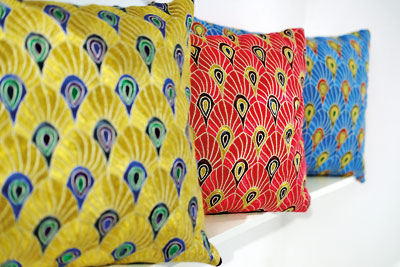Arts
Timeless blend of east and west
The afternoon sunlight slants down the cobbled Pedlar Street in Galle Fort, and Tallentire House seems to doze wrapped in a Dutch dream from the old maritime days. It must have once been a solid mansion for some Burgher family with the grand colonnaded verandah and the upper storey lined with gray fanlight windows. It breathes the character of the old fort: white-as-sea-spray, thickset but elegant, the carved wood faded, airy halls and rooms where dust motes swirl up in golden light like in a cathedral.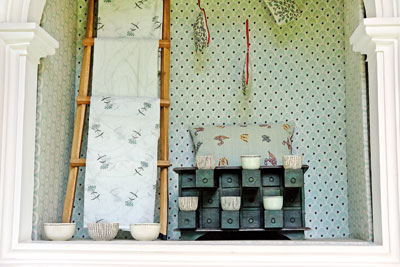
Lindsay Taylor’s fabrics look beautiful blending with this timeless setting. They have that functional elegance and beauty that comes from the stout quality of the cotton itself and the design and the colour, so you imagine the mellow cloth patterning your sofa, cushions, bolsters and beds. Her work seems a mix of the best British taste and our sunny island spirit she likes to bask in.
At the heart of Tallentire House are Lindsay’s fabrics designed by herself. But as a lifestyle store Tallentire also offers unique loungewear, ceramics, tableware, lighting and furniture. The fabrics come in two mainline collections – one bright and bold; the other more muted in colour palette – designed to allow mixing and matching of pattern and colour.
For Lindsay it all happened ‘organically’, which is just how she likes things- rather than tick off a rigorous list of goals accomplished. She has reddish blonde tresses that trail and a big smile- her willowy frame wrapped in a yellow dress. Hers is a mission to redefine home comforts and elegance, bringing in her own very unique eye into the business.
For her it all began when she came to settle down in Sri Lanka with her German husband. London born and bred, she studied textiles at the Chelsea College of Arts and had a shop in London. Later she was to embark to Namibia where her husband, a teacher, was posted. In the desert outback she was to learn pottery, which moulded her into a ceramicist. After falling in love with Sri Lanka while on holiday, they decided to make it home.
With her love for old buildings and a distinctive gift for interior designing, she took on the task of redesigning an old house in Ahangama for the family. She had a wonderful time digging into the antique shops, craft workshops and scrap yards- putting together a calm tropical gallery of a house which must be a delight to live in.
Yet when it came to the fabrics, she was disappointed. This was how she woke up to the need for good quality designer fabrics at affordable prices in the country.
For her, the landscape into which she has now blended provides endless inspiration. She finds the colours- of the land and the sea- as well as the endless diversity within the island, beautiful and stimulating. Even chance sightings from a tuktuk window- say an old gate with a curving pattern- can metamorphose into a doodle and then a design. It’s again organic.
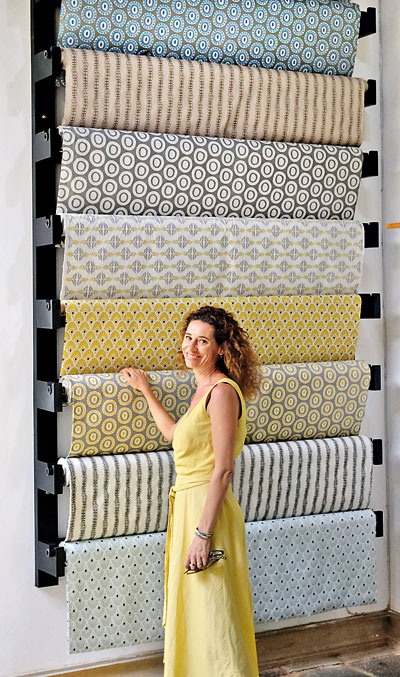
Lindsay Taylor with her fabrics and the beautifully set up design store (left and below). Pix by Amila Gamage
She is moving gradually beyond the comfort zone of textiles. Her ceramics have a simple Scandinavian charm, often with patterns of dots and holes, all done by hand.
The beauty of Lindsay’s lounge wear collection is in their very etherealness and creamy, glowing elegance. They come in exceptionally light weight fine 100% cotton voile, printed with Lindsay’s motifs inspired by nature and Japanese design.
All the fabric by Lindsay is printed, woven and embroidered in India. The stitching is done next door to Lindsay’s house- which is providential as they can easily change and modify products according to customer feedback. They also do bespoke, from upholstery to curtains.
Lindsay maintains close ties with the embroiderers and weavers, especially the artisans from Kutch who do the exquisite hand embroidery in gem colours. She lets them have a free hand with their traditional motifs and designs, rearranging them only so as to appeal to the western palate.
Lindsay is an ardent spokesperson for indigenous crafts. In a world where ‘everything is digital and everything is throw-away’, she perceives the preciousness of these items painstakingly hand done, and the need to preserve them. “Today we buy so much rubbish that we don’t actually need.” Lindsay says that ‘buy less, buy better’ would be a very wise dictum- and in all her work tries to do her best in quality.
For Lindsay, all her work is serendipity. “Often things go wrong, and so you have to work with what you are given. And I am quite good at that.” With decades of experience in India she knows how often a craftsman will put material in the wrong dye bucket, turning into crimson something that was supposed to be mustard yellow. Lindsay adapts these accidents- “with embroidery- or whatever possible.” “But I really love that process,” she says.
Lindsay is obviously endowed with the gift to put colours together. And also, consciously or not, putting cultures together. She has a smorgasbord to pick from: for the south coast has swatches of colour left behind by the Dutch and the Chinese, the British and the Moors, the Indian and the Parsee in addition to the indigenous.
Going hand in hand is her ability for reinvention. Rebuilding and upcycling are her forte. This is why ‘organic’ is a word that crops up frequently. Rather than building up from scratch, her imagination finds it easier to make changes and let things grow from an existing frame- denoting a subtle and detail-oriented mind- whether it is a farmhouse kitchen with Dutch antiques or an inner courtyard with an African antelope’s head and vintage Ceylon advertisements sharing the wall.
For the moment, Lindsay is happily anchored. Tallentire House draws in a great number of Galle Fort’s tourists- Dutch or Japanese, Australian or African, while she looks forward to opportunities of future interior projects, which would enable her to weave her subtle genius for timeless design into more and more spaces.
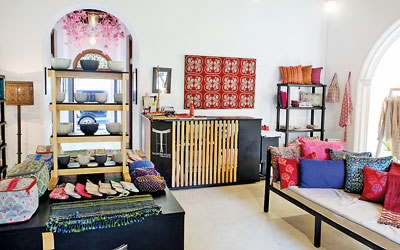
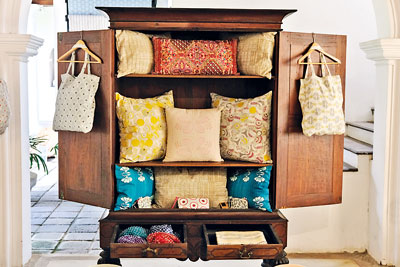
An antique cupboard full of cushions
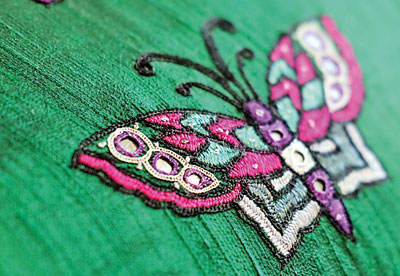
Embroidery detail
